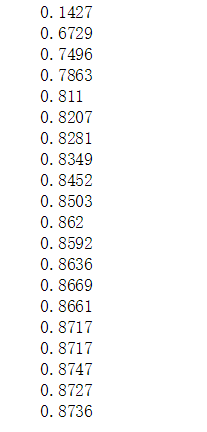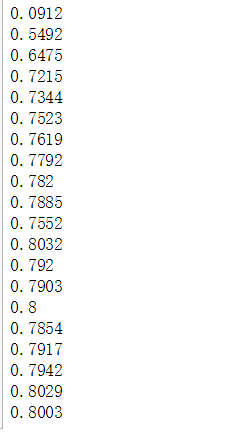TensorFlow之MNIST 分類以及Dropout的使用
阿新 • • 發佈:2018-11-10
一、簡單的一層神經網路
import tensorflow as tf
#下載MNIST資料集(28*28,輸入維度為784)
from tensorflow.examples.tutorials.mnist import input_data
mnist = input_data.read_data_sets('MNIST_data', one_hot=True)
#構建簡單的一層神經網路,包括常見引數weights、biases和activation_function #首先定義新增神經層的函式def add_layer(),它有四個引數:輸入值、輸入的大小、輸出的大小和激勵函式 def add_layer(inputs,in_size,out_size,activation_function = None): #定義weights和biases,weight為隨機變數(variable) Weights = tf.Variable(tf.random_normal([in_size,out_size]))#矩陣大小為in_size*out_size biases = tf.Variable(tf.zeros([1,out_size])+0.1)#biases不為0,加上任意一個小數值 #定義Wx_plus_b, 即神經網路未啟用的值 Wx_plus_b = tf.matmul(inputs,Weights) + biases if activation_function is None: outputs = Wx_plus_b else: outputs = activation_function(Wx_plus_b) return outputs
#定義一個計算準確率的函式 def compute_accuracy(v_xs, v_ys): global prediction y_pre = sess.run(prediction, feed_dict={xs: v_xs}) correct_prediction = tf.equal(tf.argmax(y_pre,1), tf.argmax(v_ys,1)) accuracy = tf.reduce_mean(tf.cast(correct_prediction, tf.float32)) result = sess.run(accuracy, feed_dict={xs: v_xs, ys: v_ys}) return result # 定義placeholder存放資料 xs = tf.placeholder(tf.float32, [None, 784]) ys = tf.placeholder(tf.float32, [None, 10]) #用add_layer函式搭建一個最簡單的訓練網路結構,只有輸入層和輸出層 prediction = add_layer(xs, 784, 10, activation_function=tf.nn.softmax) #損失函式(cross_entropy)和優化方法 cross_entropy = tf.reduce_mean(-tf.reduce_sum(ys*tf.log(prediction), reduction_indices=[1])) train_step = tf.train.GradientDescentOptimizer(0.5).minimize(cross_entropy) #session會話控制 sess = tf.Session() sess.run(tf.global_variables_initializer()) #訓練1000次,每訓練50次輸出測試資料的訓練精度 for i in range(1000): #開始訓練,訓練集中每次取100個數據(batch_xs, batch_ys) batch_xs, batch_ys = mnist.train.next_batch(100) sess.run(train_step, feed_dict={xs: batch_xs, ys: batch_ys})#placeholder和feed_dict同時出現 if i%50 == 0: print(compute_accuracy( mnist.test.images, mnist.test.labels))
結果為:

二、Dropout的使用
1.Dropout指部分神經元的啟用值以一定的概率p暫停工作,在這次訓練過程中不更新權值,但它的權值仍保留。
2. tf.nn.dropout
tf.nn.dropout(x, keep_prob, noise_shape=None, seed=None,name=None)
keep_prob為保留概率,即我們要保留的結果所佔比例
它作為一個placeholder,在run時傳入,一般用於全連線層。
下面在前面的程式碼的基礎上加上dropout,需要改動的地方如下
import tensorflow as tf from tensorflow.examples.tutorials.mnist import input_data mnist = input_data.read_data_sets('MNIST_data', one_hot=True)
在def layer時增加一行 Wx_plus_b = tf.nn.dropout(Wx_plus_b, keep_prob)
其餘不變
def add_layer(inputs,in_size,out_size,activation_function = None):
Weights = tf.Variable(tf.random_normal([in_size,out_size]))
biases = tf.Variable(tf.zeros([1,out_size])+0.1)
Wx_plus_b = tf.matmul(inputs,Weights) + biases
#這裡增加一行dropout
Wx_plus_b = tf.nn.dropout(Wx_plus_b, keep_prob)
if activation_function is None:
outputs = Wx_plus_b
else:
outputs = activation_function(Wx_plus_b)
return outputs注意:因為keep_prob作為一個placeholder,所以在feed_dict中傳入!
keep_prob: 1(保留全部神經元) keep_prob: 0.5(保留50%神經元)
dropout僅在train中使用,在驗證和test中keep_prob為1
#定義一個計算準確率的函式
def compute_accuracy(v_xs, v_ys):
global prediction
#keep_prob為1
y_pre = sess.run(prediction, feed_dict={xs: v_xs,keep_prob: 1})
correct_prediction = tf.equal(tf.argmax(y_pre,1), tf.argmax(v_ys,1))
accuracy = tf.reduce_mean(tf.cast(correct_prediction, tf.float32))
result = sess.run(accuracy, feed_dict={xs: v_xs, ys: v_ys,keep_prob: 1})
return resultkeep_prob作為一個placeholder,在run時傳入
增加一行:keep_prob = tf.placeholder(tf.float32)
#keep_prob作為一個placeholder,在run時傳入
keep_prob = tf.placeholder(tf.float32)
# 定義placeholder存放資料
xs = tf.placeholder(tf.float32, [None, 784])
ys = tf.placeholder(tf.float32, [None, 10])
#用add_layer函式搭建一個簡單的訓練網路結構
layer1 = add_layer(xs, 784, 50, activation_function=tf.nn.tanh)
prediction = add_layer(layer1, 50, 10, activation_function=tf.nn.softmax)
#損失函式(cross_entropy)和優化方法
cross_entropy = tf.reduce_mean(-tf.reduce_sum(ys*tf.log(prediction),
reduction_indices=[1]))
train_step = tf.train.GradientDescentOptimizer(0.5).minimize(cross_entropy)在run時傳入keep_prob
#session會話控制
sess = tf.Session()
sess.run(tf.global_variables_initializer())
#訓練1000次,每訓練50次輸出測試資料的訓練精度
for i in range(1000):
#開始訓練,訓練集中每次取100個數據(batch_xs, batch_ys)
batch_xs, batch_ys = mnist.train.next_batch(100)
sess.run(train_step, feed_dict={xs: batch_xs, ys: batch_ys, keep_prob: 0.5})#placeholder和feed_dict同時出現
if i%50 == 0:
print(compute_accuracy( mnist.test.images, mnist.test.labels))結果:(變差了,我只是隨便試一試)

